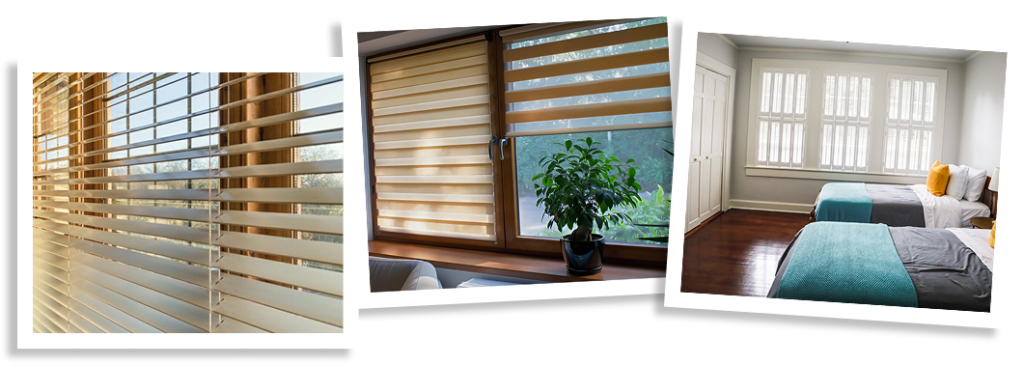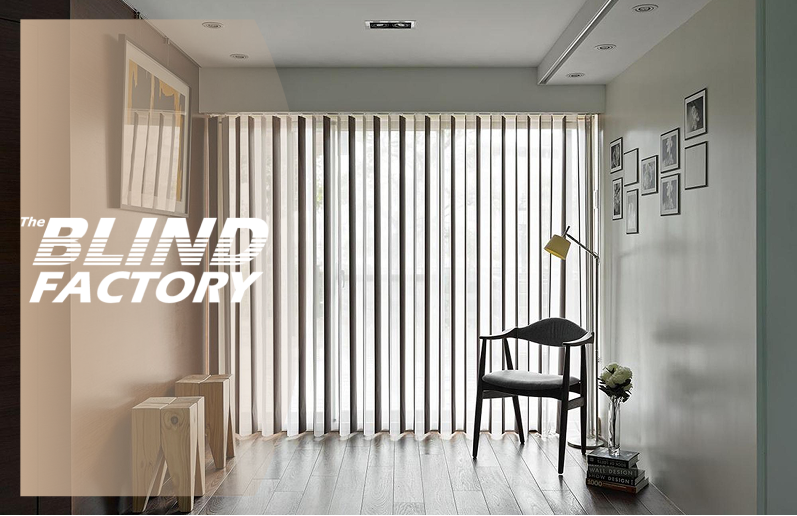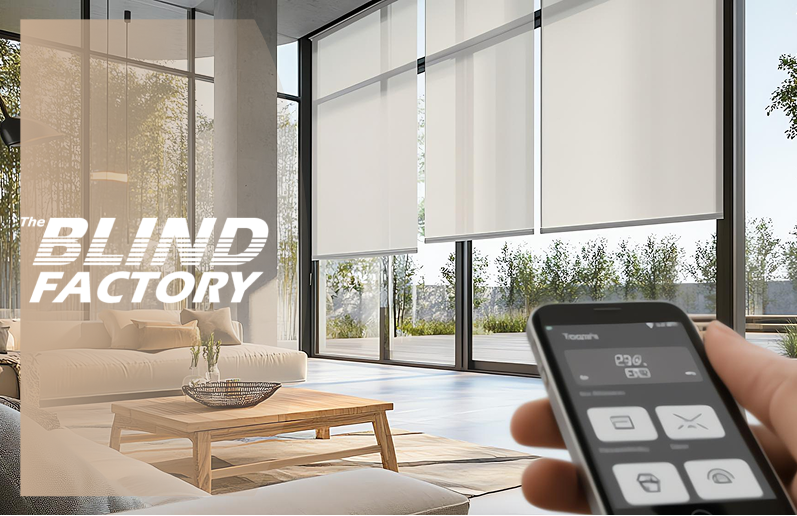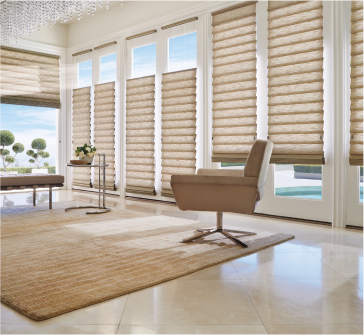Deciding on window treatments can feel overwhelming when you’re staring at blank frames waiting to be dressed. Beyond mere decoration, your choice between blinds, shades, or shutters fundamentally shapes how light, privacy, and style function in your home.
From the kitchen’s morning glow to the midnight darkness needed in bedrooms, the perfect window covering balances practicality with your unique aesthetic vision.

The Differences Between Each Window Treatment Option
Before diving into specific window treatments, it’s essential to understand the fundamental differences between blinds, shades, and shutters. Each option offers distinct benefits in terms of functionality, aesthetics, and practical application that can dramatically impact how your space looks and feels.
Blinds
Blinds feature hard slats that tilt and lift, providing adjustable light control and privacy. They use aluminum, vinyl, wood, or faux wood materials, each offering different benefits in durability, aesthetics, and maintenance requirements.
Operating mechanisms include traditional cords, safer cordless options, and convenient motorized systems that integrate with smart homes. Standard styles include horizontal Venetian blinds, vertical blinds for large openings or sliding doors, and mini blinds with narrower slats for a more subtle appearance.
Shades
Shades are soft window treatments made from continuous material that rolls or folds. They utilize fabrics ranging from sheer to blackout, natural woven materials like bamboo, or insulating cellular materials with distinctive air pockets.
These window coverings operate via continuous cord loops, cordless spring mechanisms, or motorized systems. Popular styles include simple roller shades, elegantly folding Roman shades, energy-efficient cellular/honeycomb shades, structured pleated shades that fold accordion-style, and solar shades, which reduce glare while preserving your outdoor view.
Shutters
Shutters are permanent window treatments with adjustable louvers set within framed panels, enhancing your home’s architectural character and value. They’re typically crafted from wood for classic appeal, composite materials for durability, or vinyl for moisture resistance in humid spaces.
These substantial window coverings operate using central tilt rods or concealed hidden tilt mechanisms. Common types include full-height shutters covering entire windows, tier-on-tier designs with independently operable panels, café style shutters covering only lower portions, and plantation shutters with wider louvers for maximum visibility when open—and when adapted for larger openings, plantation shutters for sliding glass doors provide the same sophistication and light control, tailored to high-traffic patio spaces. While shutters don’t typically come with motorized options, some high-end systems allow smart louver adjustment.
What to Consider When Choosing
Choosing between window treatments comes down to what matters most in your space. Each option has distinct advantages that affect your comfort, style, and budget in different ways.
Light Control
Blinds offer precise control through adjustable slats that direct sunlight exactly where you need it throughout the day, but they don’t fully block out light due to small gaps between slats.
Shades provide different levels of light filtering, from sheer options that diffuse light to room-darkening and blackout varieties for complete darkness. However, they don’t allow fine-tuned control like blinds or shutters—you can only adjust how much they are raised or lowered.
Shutters deliver customizable lighting through adjustable louvers that can be positioned at various angles, balancing privacy and natural light. While they offer excellent light control, they may not darken a room as effectively as blackout shades.
Privacy
Blinds provide flexible privacy with slats that can be angled to block sightlines while still allowing light to filter through.
Shades with top-down/bottom-up functionality offer unique versatility, allowing natural light from above while maintaining privacy at eye level.
Shutters create substantial privacy with solid frames and adjustable louvers that can be fully closed for complete coverage or opened wide when you want to connect with the outdoors.
Energy Efficiency
Blinds provide moderate insulation and effectively reflect summer heat, though gaps between slats limit their thermal performance in colder weather.
Cellular shades offer superior year-round insulation with their honeycomb pockets that trap air and create effective barriers against both heat loss and gain.
Shutters deliver excellent energy efficiency with their substantial construction and tight seal against window frames, significantly reducing drafts in all seasons. However, they generally don’t outperform high-quality cellular shades in terms of R-value.
Maintenance and Durability
Blinds require regular dusting and occasional deeper cleaning, with the potential drawback of bent or broken slats in active households.
Fabric shades need specific cleaning approaches based on material type, with some vulnerability to staining and fading in intense sunlight.
Shutters stand as the most durable option with simple wipe-down maintenance, resistance to damage, and exceptional longevity that often spans decades with minimal upkeep. However, real wood shutters may warp in extreme humidity, making composite or vinyl better choices for moisture-prone areas.
Aesthetics and Design Impact
Blinds present a clean, streamlined appearance that complements various design styles without overwhelming your other décor elements.
Shades add warmth and texture through fabric varieties, offering design flexibility with patterns, colors, and materials that can become focal points in your space.
Shutters make an architectural statement with their substantial presence, adding timeless elegance that enhances your home’s character both inside and out.
Cost Considerations
Blinds typically offer the most affordable starting point, with pricing that increases based on material quality, from vinyl to premium hardwoods.
Shades fall in the mid-range price category, with costs varying based on fabric quality, special features, and energy-efficient designs.
Shutters represent a higher initial investment but offer long-term value through durability, energy savings, and increased property appeal—often lasting the lifetime of your home.

Room-by-Room Recommendations
Different spaces in your home have unique requirements for light control, privacy, and durability. Here’s what works best in each room:
Living Room/Family Room
For living spaces where you entertain guests and gather with family, layered window treatments often work best. Consider pairing shades with decorative drapes for a finished look that offers flexibility. Plantation shutters make a stunning statement in living rooms, adding architectural interest while providing excellent light control. For large picture windows, vertical blinds or panel track shades prevent overwhelming the space while managing light and privacy effectively.
Bedrooms
In bedrooms, prioritize treatments that block light and enhance privacy. Room-darkening or blackout roller shades create ideal sleeping conditions and pair beautifully with decorative curtains for a layered look. In children’s rooms, cordless options eliminate safety hazards, while blackout features support healthy sleep patterns. Master bedrooms benefit from dual shades (light-filtering and blackout) or shutters paired with drapery for ultimate flexibility and a touch of luxury.
Kitchen
Kitchen windows demand treatments that resist moisture, grease, and food stains. Faux wood blinds offer the warm wood look with superior moisture resistance and easy cleaning. Vinyl shutters provide substantial style with exceptional durability in this high-humidity environment. For a softer option, washable Roman shades in treated fabrics bring color and pattern while standing up to kitchen conditions.
Bathroom
Bathroom window treatments must balance privacy with moisture resistance. Top-down/bottom-up cellular shades allow natural light through the upper portion while maintaining privacy. Vinyl or composite shutters resist warping in humid conditions while offering complete privacy control. For shower windows, consider frosted window film paired with water-resistant treatments or moisture-proof vinyl blinds that provide privacy without absorbing bathroom humidity.
Home Office
In-home offices manage screen glare while maintaining a professional backdrop for video calls. Light-filtering roller shades diffuse harsh sunlight without darkening the space. For video conference aesthetics, consider wood or faux wood blinds that create a polished background appearance. Shutters offer excellent light control with minimal maintenance, allowing you to adjust louvers throughout the day as the sun position changes.
Sunrooms/Large Window Areas
Sunrooms and walls of windows present unique challenges in light and temperature management. Motorized shades offer convenient operation for hard-to-reach windows and can be programmed to adjust with the sun’s position.
Vertical blinds or panel track systems work well for sliding doors and wide windows, providing flexible light control without the bulk of fabric treatments.
For temperature regulation, cellular shades with high R-value insulation help maintain comfortable conditions year-round. Solar shades are another excellent choice, reducing glare and UV exposure while maintaining your view.

Are There Special Situations to Consider?
Even the most straightforward window treatment decisions can become complex in certain situations.
Here’s what to consider when dealing with smart home integration, safety concerns, or architectural challenges.
Smart Home Integration
Today’s window treatments connect seamlessly with smart home systems.
- Blinds offer motorized options controllable via apps or voice commands.
- Shades provide advanced motorization, including scheduling based on the time of day and integration with temperature sensors.
- Shutters have fewer motorization options, though premium systems allow louver adjustment through smart controls.
Child and Pet Safety
Homes with children and pets need thoughtful choices.
- Cordless blinds eliminate dangerous dangling cords while retaining functionality.
- Roller and Roman shades now come in cordless designs using spring mechanisms.
- For pet durability, avoid delicate fabrics and consider aluminum blinds, faux wood products, or shutters that resist scratching and damage.
Unusual Window Shapes
Architectural windows require specialized solutions.
- Arched windows can be fitted with custom cellular shades that preserve character while adding insulation.
- Angled skylights benefit from motorized tension shades designed to work against gravity.
- Circular windows pair beautifully with custom shutters featuring specialized hinges that maintain the round shape while providing functional control.
Your Window to Comfort and Style
Choosing the right window treatment is ultimately about finding the perfect balance between function and style for your unique space. Whether you prioritize light control, energy efficiency, or design impact, blinds, shades, and shutters, each offer distinct advantages that can transform your windows into standout features.
Consider your specific room needs, lifestyle factors, and budget constraints as you make your selection—and remember that mixing different treatments throughout your home often creates the most satisfying result.

